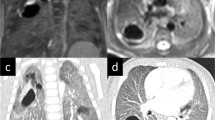Abstract
The purpose is to determine the accuracy of chest radiography for evaluating significantly abnormal pulmonary vascularity in children with congenital heart disease. This retrospective study included 120 children. Forty pediatric congenital heart disease patients with a ratio of pulmonary to systemic blood flow (Qp:Qs) lower than 0.8 by cardiac catheterization were enrolled as the decreased pulmonary vascularity group. Another forty pediatric congenital heart disease patients with a Qp:Qs higher than 1.5 were enrolled as the increased pulmonary vascularity group. Forty pediatric patients who had no cardiopulmonary problems were enrolled as the normal control group. All chest radiographs were reviewed by three readers. The results were compared to cardiac catheterization as a gold standard. Linear weighted kappa test was used to determine intra- and inter-observer agreements. The accuracy, specificity, positive predictive value, and negative predictive value of chest radiography to characterize pulmonary vascularity patterns in the three groups were moderate to high, falling between 73 and 92 %, 61 and 96 %, 71 and 94 %, and 71 and 98 %, respectively. The sensitivity of chest radiography to interpret decreased pulmonary vascularity patterns was low (24–68 %), whereas the sensitivity to interpret normal and increased pulmonary vascularity patterns were high (84–94 %). The inter-observer agreement was moderate to good (k = 0.53–0.67). The intra-observer reliability was good (k = 0.71–0.79). Pediatric chest radiography exhibits good accuracy and reproducibility to identify significantly abnormal pulmonary vascularity in children with congenital heart disease. However, the sensitivity to detect decreased pulmonary vascularity pattern is low.



Similar content being viewed by others
References
Pongpanich B, Dhanavaravibul S, Limsuwan A (1976) Prevalence of heart disease in school children in Thailand: a preliminary survey at Bang Pa-in. Southeast Asian J Trop Med Public Health (1):91–94
Ferencz C, Rubin JD, McCarter RJ et al (1985) Congenital heart disease: prevalence at livebirth. The Baltimore-Washington Infant Study. Am J Epidemiol 121(1):31–36
Marelli AJ, Mackie AS, Ionescu-Ittu R et al (2007) Congenital heart disease in the general population: changing prevalence and age distribution. Circulation 115(2):163–172
Birkebaek NH, Hansen LK, Elle B et al (1999) Chest roentgenogram in the evaluation of heart defects in asymptomatic infants and children with a cardiac murmur: reproducibility and accuracy. Pediatrics 103(2):E15
Laya BF, Goske MJ, Morrison S et al (2006) The accuracy of chest radiographs in the detection of congenital heart disease and in the diagnosis of specific congenital cardiac lesions. Pediatr Radiol 36(7):677–681
Tsuji M (1993) Evaluation of pulmonary arterial trunk on frontal chest radiograph in patients with atrial septal defects. Nihon Igaku Hoshasen Gakkai Zasshi 53(6):667–678
Wilkinson JL (2001) Haemodynamic calculations in the catheter laboratory. Heart 85(1):113–120
Park MK (2007) Catheter intervention procedures. In: Park MK (ed) Pediatric cardiology for practitioners, 5th edn. Mosby, New York, pp 155–159
Kerr IH (1970) Vascular changes in the lungs on the plain radiograph of the chest. Postgrad Med J 46(531):3–10
Ravin CE (1983) Radiographic analysis of pulmonary vascular distribution: a review. Bull N Y Acad Med 59(8):728–743
Landis JR, Koch GG (1977) The measurement of observer agreement for categorical data. Biometrics 33(1):159–174
Baumgartner H, Bonhoeffer P, De Groot NM et al (2010) ESC Guidelines for the management of grown-up congenital heart disease (new version 2010). Eur Heart J 31(23):2915–2957
Arnois DC, Silverman FN, Turner ME (1959) The radiographic evaluation of pulmonary vasculature in children with congenital cardiovascular disease. Radiology 72(5):689–698
Diethelm E, Soto B, Nath PH et al (1985) The pulmonary vascularity in patients with pulmonary atresia and ventricular septal defect. Radiographics 5(2):243–254
Bush A, Gray H, Denison DM (1988) Diagnosis of pulmonary hypertension from radiographic estimates of pulmonary arterial size. Thorax 43(2):127–131
Coussement AM, Gooding CA (1973) Objective radiographic assessment of pulmonary vascularity in children. Radiology 109(3):649–654
Acknowledgments
This study was supported by the second Advanced School for Core Investigators from Asian Society of Cardiovascular Imaging Program 2011. The statistics were supported by Chula Clinical Research Center, Faculty of Medicine, Chulalongkorn University.
Conflict of interest
None.
Author information
Authors and Affiliations
Corresponding author
Rights and permissions
About this article
Cite this article
Tumkosit, M., Yingyong, N., Mahayosnond, A. et al. Accuracy of chest radiography for evaluating significantly abnormal pulmonary vascularity in children with congenital heart disease. Int J Cardiovasc Imaging 28 (Suppl 1), 69–75 (2012). https://doi.org/10.1007/s10554-012-0073-x
Received:
Accepted:
Published:
Issue Date:
DOI: https://doi.org/10.1007/s10554-012-0073-x




